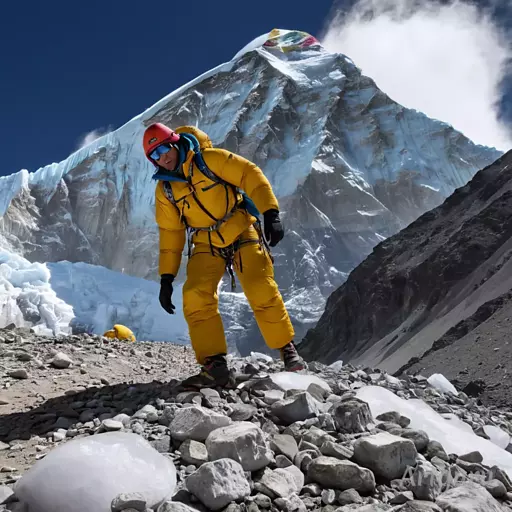Mount Everest, the tallest peak on Earth, has witnessed a surge in climbers over the past few years. This increase in foot traffic, however, has brought about a concerning issue – the accumulation of waste. Local authorities in Nepal have recently announced a new regulation mandating climbers to descend with their own waste, including human excrements. This article explores the reasons behind this decision and proposes solutions to mitigate the environmental impact.
History of Mount Everest Climbing
For decades, adventurers and mountaineers have been drawn to the challenge of conquering Everest. Since Sir Edmund Hillary and Tenzing Norgay’s historic ascent in 1953, climbing expeditions to Everest have become increasingly popular. However, with popularity comes a host of challenges, including environmental degradation.
Increasing Number of Climbers
In recent years, there has been a significant increase in the number of climbers attempting to summit Everest. Improved accessibility, advances in technology, and a growing interest in extreme sports have all contributed to this surge in climbers. While this trend brings economic benefits to the region, it also exacerbates environmental concerns.
Environmental Impact
The influx of climbers has led to the accumulation of waste on Everest’s slopes. Campsites are littered with discarded equipment, food wrappers, and human waste. This not only detracts from the natural beauty of the mountain but also poses serious health risks to climbers and local communities.
Accumulation of Waste
The sheer volume of waste generated by climbers poses a logistical challenge. Traditional waste management systems are inadequate to handle the scale of the problem. As a result, waste accumulates at base camps and along climbing routes, contaminating the environment and endangering wildlife.
Health Hazards
Human waste, in particular, poses significant health hazards. Contaminated water sources can lead to the spread of waterborne diseases among climbers and Sherpa guides. Additionally, the accumulation of waste contributes to pollution and soil erosion, further degrading the fragile ecosystem of the Everest region.
Local Authorities’ Response
Recognizing the urgency of the situation, local authorities in Nepal have implemented new regulations to address the issue of waste management on Everest. Among these regulations is a requirement for climbers to carry out all their waste, including human excrements, when descending from the mountain.
New Regulations
The new regulations aim to mitigate the environmental impact of climbing activities on Everest. Climbers are now required to bring biodegradable waste bags and portable toilets with them on their ascent. Failure to comply with these regulations may result in fines or even expulsion from the mountain.
Challenges in Waste Management
While the new regulations are a step in the right direction, they also present challenges in waste management. The remote and inhospitable terrain of Everest makes it difficult to transport and dispose of waste effectively. Additionally, the high altitude and extreme weather conditions further complicate waste management efforts.
Potential Solutions
Addressing the waste problem on Everest requires a multi-faceted approach. In addition to regulatory measures, there is a need for innovative solutions to minimize waste generation and facilitate its proper disposal.
Biodegradable Options
Encouraging the use of biodegradable materials can help reduce the environmental impact of climbing activities. Biodegradable waste bags, food packaging, and toiletries can minimize the accumulation of non-biodegradable waste on the mountain.
Education and Awareness
Raising awareness among climbers about the importance of environmental conservation is essential. Educational programs can inform climbers about the impact of their actions on Everest’s ecosystem and empower them to adopt sustainable practices.
Role of Climbing Expeditions
Climbing expeditions have a crucial role to play in promoting responsible tourism on Everest. By adhering to sustainable practices and minimizing their environmental footprint, expeditions can set a positive example for others to follow.
Future Prospects
The issue of waste management on Everest is complex and multifaceted. However, with concerted efforts from climbers, local communities, and government agencies, it is possible to address this challenge and preserve the pristine beauty of the world’s tallest peak for future generations.
Conclusion
The new regulations mandating climbers to carry out their waste from Everest mark a significant step towards mitigating the environmental impact of climbing activities. By implementing these regulations and exploring innovative solutions, we can ensure that Everest remains a symbol of natural beauty and adventure for years to come.
Unique FAQs
- Q: Why are climbers now required to carry out their waste from Everest? A: The accumulation of waste on Everest poses serious environmental and health risks, prompting local authorities to implement new regulations to address the issue.
- Q: What are some of the challenges in waste management on Everest? A: The remote and inhospitable terrain, along with the high altitude and extreme weather conditions, present significant challenges in transporting and disposing of waste effectively.
- Q: How can climbers minimize their environmental impact on Everest? A: Climbers can minimize their environmental impact by adhering to sustainable practices, such as using biodegradable materials and properly disposing of their waste.
- Q: What role do climbing expeditions play in addressing the waste problem on Everest? A: Climbing expeditions can set a positive example for responsible tourism by adopting sustainable practices and raising awareness about the importance of environmental conservation.
- Q: What are some potential solutions to the waste problem on Everest? A: Potential solutions include encouraging the use of biodegradable materials, implementing educational programs for climbers, and improving waste management infrastructure.



